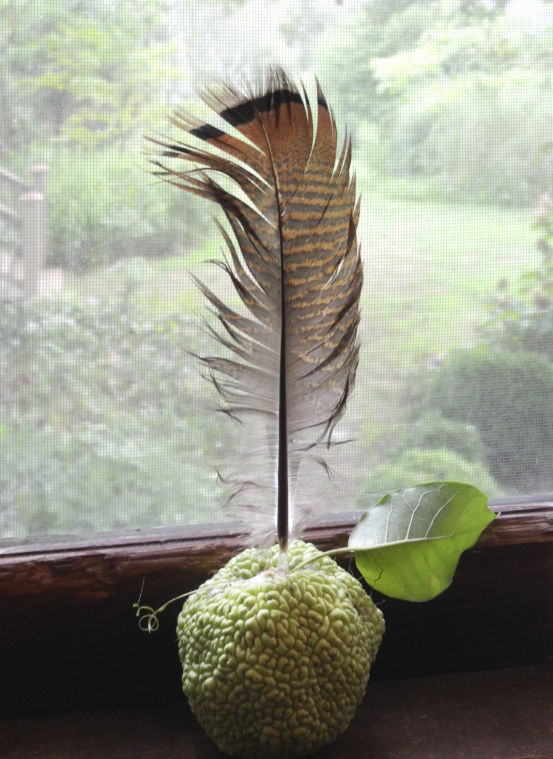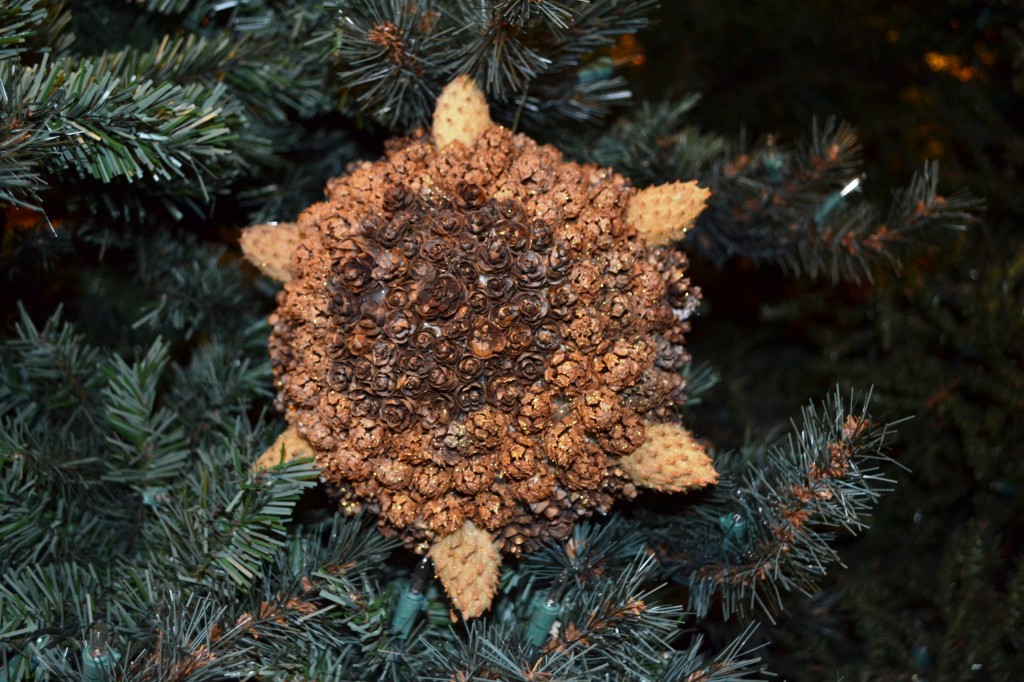Gardening: Natural Decorations Bring the Outdoors In
by Lynn Kirk, Public Relations Writer, Lewis Ginter Botanical Garden, reprinted with permission from the Richmond Times-Dispatch

A native Osage orange brandishes a wild turkey feather with distinctive holiday flair. Photo by Nancy Ross Hugo
This year as you deck your halls, why not opt for real boughs of holly? With natural decorations instead of synthetic reproductions, the holidays become another opportunity to “go green.” Repurposing nature’s bounty into holiday wreaths, garlands and centerpieces showcases your appreciation of nature. It also doubles as a low-cost DIY project that’s sprinkled with seasonal fun.
“Decorating with natural plants is a way to bring nature inside,” said Alexander J. Elton, a consulting arborist with Arborscapes. “Most people personalize their landscape so it means something to them. When they bring different plants inside for the holidays they are reminded of special places, people or jobs from their past.”
Adventure and exercise are bonus benefits of exploring landscapes, gardens and woodlands during the gathering process. Elton recommended obtaining landowner permission before the hunt, and looking for color and fragrance as well as beauty and uniqueness.
Greenery is perhaps the easiest to find, but don’t overlook seed heads, seedpods, fallen deciduous leaves and sprays of berries that offer contrasting hues and textures. Some natural resources work best as fresh cuttings, while many leaves and flowers must be preserved in advance for use later during the holiday season. Another key is letting nature motivate you to harvest and create what interests you.
Inspired by Colonial Williamsburg and family traditions, Elton takes the idea of “all natural” one step further. When he harvests items for holiday décor, he focuses on native plants: those originating in this region before European settlement.
“Virginia’s native plants encourage thinking about the history of the area,” he said. “You’re carrying on a tradition by decorating just like people have been doing for hundreds of years.”
Back-to-nature decorating tips
• Remember that cutting shrubs and trees for holiday decorations doubles as pruning, so carefully consider where to cut for maintaining the plant’s natural form. Prune branches that butt against structures or cross other limbs, and always take the cut back to a lateral branch.
• Some berries are poisonous, such as mistletoe, so keep those arrangements and small objects out of reach for small children and pets.
• Cuttings may last longer if the freshly cut ends are soaked overnight in water or sprayed with an anti-transpirant that reduces water loss. Research what works best with each plant before treating, since some foliage may turn black, become sticky or wither more quickly if improperly treated.
• The same applies to preserving leaves, flowers and stems. Determine whether the plant typically responds better to air drying or silica gel.
• Identify plants before cutting. Poison ivy can add color, but the inherent cost could be an itchy rash.
• Avoid at-risk native species and insect-infested plants.
• Regularly check natural decorations for freshness, and have a backup plan for replacing fresh greenery.
• Recycle or compost spent greenery.
Sampling of Virginia’s native decoratives:
• Evergreens: White pine, loblolly pine,
longleaf pine, American holly, Atlantic white cedar, Eastern red cedar, North American fir
• Leaves: Southern magnolia, mountain laurel, galax
• Branches: Red-twig dogwood
• Berried shrubs: Winterberry, mistletoe
• Acorns: Willow oak, burr oak, overcup oak
• Cones: Eastern hemlock, loblolly pine,
longleaf pine
• Bark: River birch
• Seedpods/Seed heads: Sweetgum, tulip poplar, Southern magnolia, Virginia thistle, cattails
• Branches: Maple, birch, wild rose, willow
• Leaves: Sassafras, red maple, silver maple
• Flowers*: Oakleaf hydrangea, flowering dogwood
*Harvest at prime bloom during growing
season, then preserve and store until needed.

Native magnolia seedpods and hemlock cones are paired with cones from non-native Japanese cryptomeria.
Editor’s Note: This article first published in the Richmond Times-Dispatch, in December 2013.
